中考英语语法专项突破专题03+冠词 课件(共27张PPT)
文档属性
| 名称 | 中考英语语法专项突破专题03+冠词 课件(共27张PPT) | 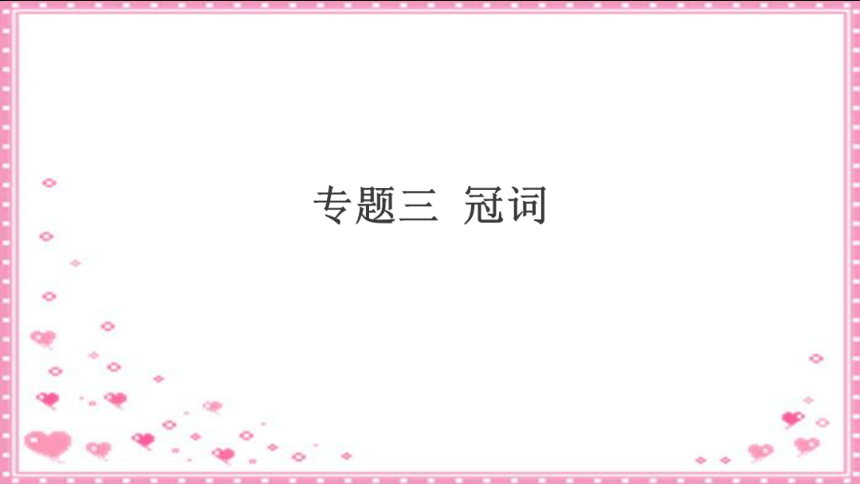 | |
| 格式 | pptx | ||
| 文件大小 | 2.2MB | ||
| 资源类型 | 教案 | ||
| 版本资源 | 通用版 | ||
| 科目 | 英语 | ||
| 更新时间 | 2023-10-21 21:23:28 | ||
图片预览

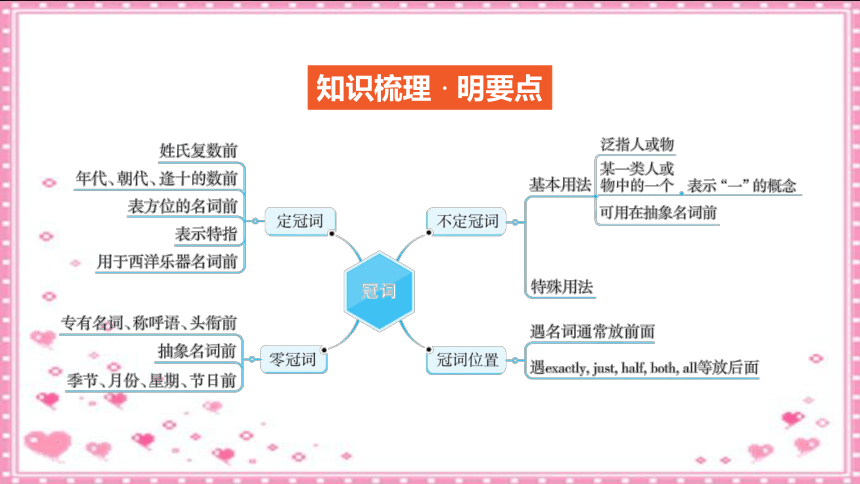
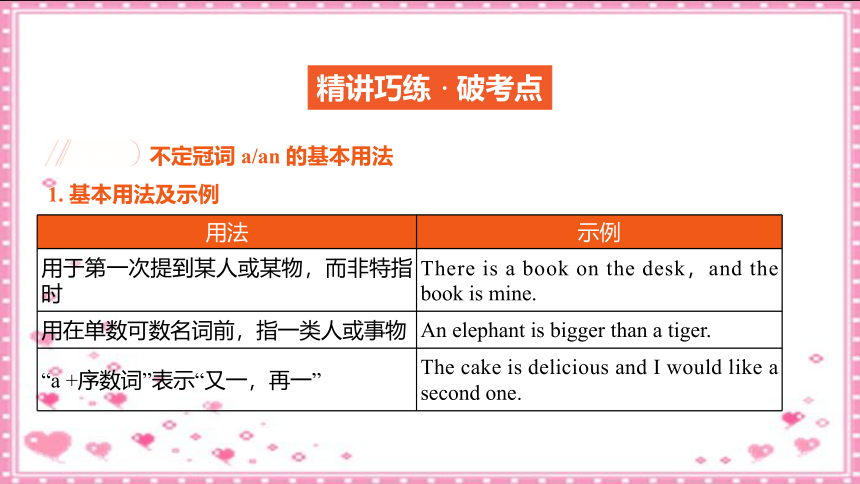

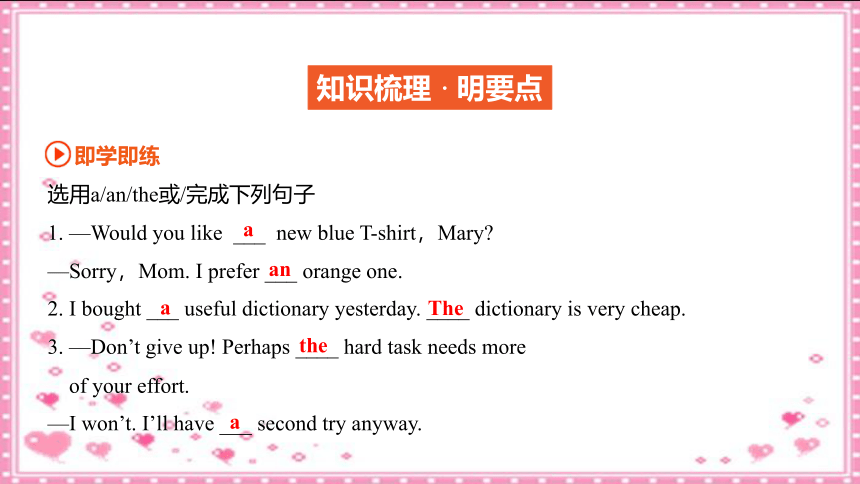

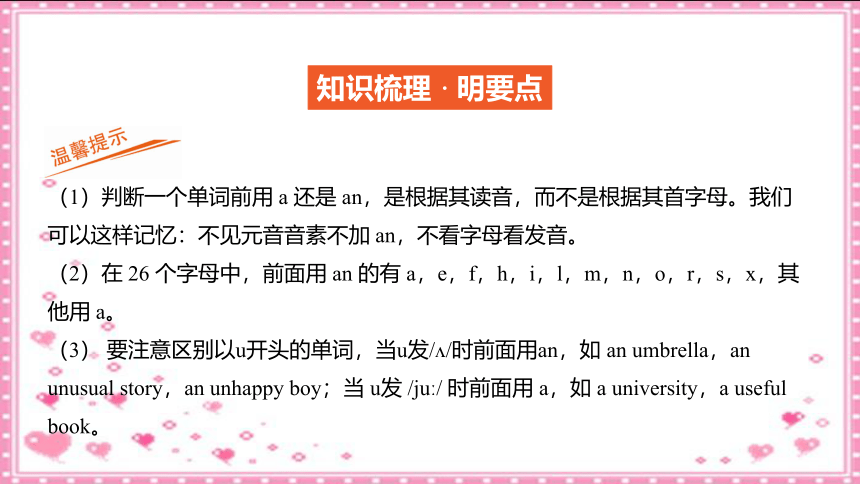
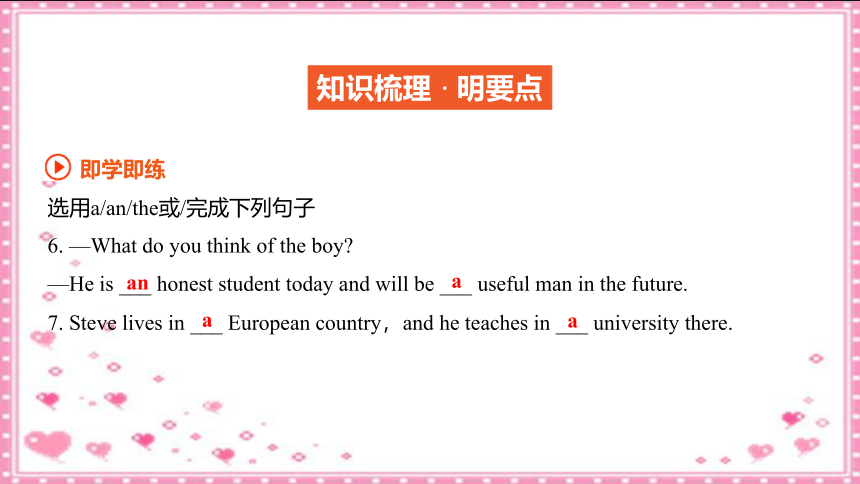
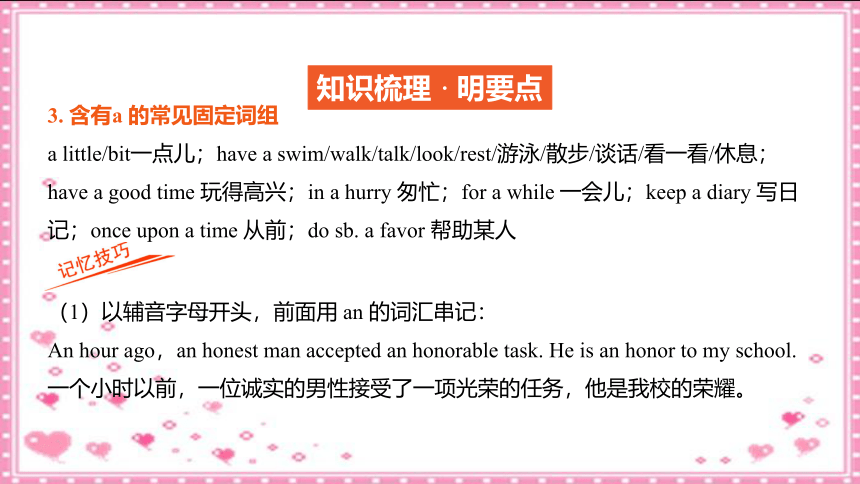
文档简介
(共27张PPT)
专题三 冠词
考点 1 不定冠词 a/an 的基本用法
1. 基本用法及示例
用法 示例
用于第一次提到某人或某物,而非特指时 There is a book on the desk,and the book is mine.
用在单数可数名词前,指一类人或事物 An elephant is bigger than a tiger.
“a +序数词”表示“又一,再一” The cake is delicious and I would like a second one.
用于可视为一个整体的两个名词前 a knife and fork 一副刀叉
用于表示时间、速度、价格等意义的名词前,有“每一”的意思,相当于every three times a week,five lessons a week
用在抽象名词前,表示“某件……的事或某个……的人”,即抽象名词具体化 It is a pleasure to talk with you.
用在quite,rather,many,half,what,such之后 This room is rather a big one.
用于“so(as,too,how)+形容词”之后 She is as clever a girl as you wish to meet.
即学即练
选用a/an/the或/完成下列句子
1. —Would you like ___ new blue T-shirt,Mary
—Sorry,Mom. I prefer ___ orange one.
2. I bought ___ useful dictionary yesterday. ____ dictionary is very cheap.
3. —Don’t give up! Perhaps ____ hard task needs more
of your effort.
—I won’t. I’ll have ___ second try anyway.
a
an
a
The
the
a
4. The man is driving at 40 kilometres ___ hour.
5. That performance was ___ great success. The audience couldn’t stop clapping their hands.
2. 不定冠词 a/an 的用法区别
a 用在读音以辅音音素开头的单词前 a teacher,a good student
an 用在读音以元音音素开头的单词前 an apple tree,an interesting story
an
a
(1)判断一个单词前用 a 还是 an,是根据其读音,而不是根据其首字母。我们可以这样记忆:不见元音音素不加 an,不看字母看发音。
(2)在 26 个字母中,前面用 an 的有 a,e,f,h,i,l,m,n,o,r,s,x,其他用 a。
(3) 要注意区别以u开头的单词,当u发/ /时前面用an,如 an umbrella,an unusual story,an unhappy boy;当 u发 /ju / 时前面用 a,如 a university,a useful book。
即学即练
选用a/an/the或/完成下列句子
6. —What do you think of the boy
—He is ___ honest student today and will be ___ useful man in the future.
7. Steve lives in ___ European country,and he teaches in ___ university there.
an
a
a
a
3. 含有a 的常见固定词组
a little/bit一点儿;have a swim/walk/talk/look/rest/游泳/散步/谈话/看一看/休息;have a good time 玩得高兴;in a hurry 匆忙;for a while 一会儿;keep a diary 写日记;once upon a time 从前;do sb. a favor 帮助某人
(1)以辅音字母开头,前面用 an 的词汇串记:
An hour ago,an honest man accepted an honorable task. He is an honor to my school. 一个小时以前,一位诚实的男性接受了一项光荣的任务,他是我校的荣耀。
(2)以元音字母开头,前面用 a 的词汇串记:
In a university,a European walked along a one-way road with a useful thing. This is a usual thing. 在一所大学 里,一个欧洲人拿着一个有用的东西沿着一条单行道行
走。这是一件平常的事。
即学即练
选用a/an/the或/完成下列句子
8. I usually ride___ bike to school. But this morning,I went to school by ___bus.
9. The students always take ____ active part in volunteer work during the summer vacation.
a
/
an
考点 2 定冠词 the 的用法
1. 定冠词the 的基本用法
特指某(些)人或物 This is the house where Lu Xun once lived.
用在单数可数名词前,表示某一类人或事物 The tiger is a dangerous animal.
用以复述上文提过的人或事物(第一次提到用a或an,以后再次提到用the) I had a present today. The present came from my mother.
用在谈话双方都知道的人或事物前 Give me the book,please.
用在表示世界上独一无二的事物前 The moon moves around the earth.
用在序数词、形容词的最高级之前以及对两个人或事物进行比较时的比较级之前 The first lesson is very easy.
He is the younger of the two boys.
和某些形容词连用,表示一类人或事物 the old the sick
the blind
用在姓氏的复数形式前,表示“……一家人或……夫妇” the Greens
the Browns
用在江河、海洋、山脉、湖泊、群岛等专有名词前,或由普通名词构成的专有名词前 the Great Wall
the Summer Palace
the Pacific Ocean
the Yellow River
用在方位名词或乐器名词前 on the left
in the east/west
play the piano
play the violin
在逢十的复数数词之前,指某世纪的某个年代 in the 1990s
用于身体部位名词以及表示时间的词组前 He patted me on the shoulder.
当定冠词与all,half,both等词连用修饰名词时,定冠词放在这些词之后 Look! All the books are here. They walked half the journey.
即学即练
选用a/an/the或/完成下列句子
1. —Look at ____boy over there. He looks excited.
—Yeah, he has won first prize in the school English Reading & Writing Competition.
2. ___ new bridge has been built over ____ Yangtze River in the city.
3. 伤员被立即送往医院。
_______________________________________
the
A
the
The wounded were sent to the hospital at once.
2.定冠词the 常用于某些固定短语中
in the morning/afternoon/evening 在上午/下午/晚上
in the daytime在白天 in the end 最后
all the time 一直 at the same time 同时
by the way 顺便说一下 in the open air 在户外
at the age of 在……岁时 at the beginning of 在……的开始
on the other side of 在……的另一边 in the middle of 在……中间
in the north of在……的北部 at the moment 立刻,马上
冠词 the 的用法口诀
特指双方熟悉,上文已经提及。
世上独一无二,方位、乐器名词。
某些专有名词,外加复数姓氏。
序数词最高级,习惯用语特殊记。
即学即练
4. 最后,他找到了他丢失的书包。
___________________________________
5. 第二天早上,她没有吃早饭就去上学了。
_________________________________________________
In the end,he found his lost schoolbag.
The next morning,she went to school without breakfast.
考点 3 零冠词的用法
1. 下列情况用零冠词
不可数名词或复数名词前表泛指时 Children shouldn’t tell lies.
Visitors are not admitted.
某些专有名词(如人名、地名、国家名)、物质名词和抽象名词表泛指时 China is a great country.
Music can bring people pleasure.
如果名词前已有指示代词(this,that,these,those)、形容词性物主代词(my,his,our)、名词所有格或不定代词等限定词,不用冠词 This city is so beautiful.
I can wait,but my tooth can’t.
在称呼语或表示头衔的名词前 This is Professor Li.
在表示学科、三餐、球类、棋类、游戏名称前,一般不用冠词 I went to school without break-fast this morning.
He likes playing football/chess.
由“专有名词+普通名词”构成的表示街名、路名、山名等的词前 Nanjing Road,Mount Tai
与by连用表示交通方式的名词前 by train,by air,by land
在节日名词前 New Year’s Day,Women’s Day
即学即练
1. 拉完小提琴,我将邀请Tom吃午饭。
_______________________________________________
2. 在儿童节,Mary因为是一个诚实的女孩而获奖。
_________________________________________________________
I’ll invite Tom to have lunch after playing the violin.
On Children’s Day,Mary received a prize for being an honest girl.
2. 在某些固定词组或习惯用语中,不用冠词
day after day 日复一日地 day and night日日夜夜
hand in hand 手牵手 side by side 肩并肩
sooner or later 迟早 by mistake 错误地
at first 开始,首先 at last 最后
at school 在上学 at home在家
at once 立刻 at noon 在中午
at night 在晚上 at work 在工作
on time 准时 on business 出差
on holiday 在度假 in class在课堂上
go swimming/shopping/boating/fishing
去游泳/购物/划船/钓鱼
巧记不用冠词的情况
下列情况不用冠词,名词之前代词限。
复数名词表泛指,球类、学科和三餐。
专有名词和语言,星期、月份、季节前。
交通手段和节日,习惯称谓和头衔。
在有些词组中,有无冠词,意义差别很大:
at school 在上学 at the school 在学校里
at table 在吃饭 at the table 在桌旁
in bed (生病)卧床 in the bed 在床上
in hospital(生病)住院 in the hospital 在医院里
by sea 乘船 by the sea 在海边
on earth 究竟,到底 on the earth 在地球上
in front of 在……前面(外部)
in the front of 在……前面(内部)
go to church 去做礼拜 go to the church 去教堂
Alice had a fever yesterday. She is in hospital now.
昨天爱丽丝发烧了,现在她住院了。
Her mother is a doctor. She works in the hospital.
她的妈妈是一名医生,在医院里工作。
即学即练
3. 这个学期你的英语取得了巨大进步。
________________________________________________
4. 他们想让他们的女儿去上大学。
_______________________________________
You have made great progress in your English this term.
They want their daughter to go to university.
专题三 冠词
考点 1 不定冠词 a/an 的基本用法
1. 基本用法及示例
用法 示例
用于第一次提到某人或某物,而非特指时 There is a book on the desk,and the book is mine.
用在单数可数名词前,指一类人或事物 An elephant is bigger than a tiger.
“a +序数词”表示“又一,再一” The cake is delicious and I would like a second one.
用于可视为一个整体的两个名词前 a knife and fork 一副刀叉
用于表示时间、速度、价格等意义的名词前,有“每一”的意思,相当于every three times a week,five lessons a week
用在抽象名词前,表示“某件……的事或某个……的人”,即抽象名词具体化 It is a pleasure to talk with you.
用在quite,rather,many,half,what,such之后 This room is rather a big one.
用于“so(as,too,how)+形容词”之后 She is as clever a girl as you wish to meet.
即学即练
选用a/an/the或/完成下列句子
1. —Would you like ___ new blue T-shirt,Mary
—Sorry,Mom. I prefer ___ orange one.
2. I bought ___ useful dictionary yesterday. ____ dictionary is very cheap.
3. —Don’t give up! Perhaps ____ hard task needs more
of your effort.
—I won’t. I’ll have ___ second try anyway.
a
an
a
The
the
a
4. The man is driving at 40 kilometres ___ hour.
5. That performance was ___ great success. The audience couldn’t stop clapping their hands.
2. 不定冠词 a/an 的用法区别
a 用在读音以辅音音素开头的单词前 a teacher,a good student
an 用在读音以元音音素开头的单词前 an apple tree,an interesting story
an
a
(1)判断一个单词前用 a 还是 an,是根据其读音,而不是根据其首字母。我们可以这样记忆:不见元音音素不加 an,不看字母看发音。
(2)在 26 个字母中,前面用 an 的有 a,e,f,h,i,l,m,n,o,r,s,x,其他用 a。
(3) 要注意区别以u开头的单词,当u发/ /时前面用an,如 an umbrella,an unusual story,an unhappy boy;当 u发 /ju / 时前面用 a,如 a university,a useful book。
即学即练
选用a/an/the或/完成下列句子
6. —What do you think of the boy
—He is ___ honest student today and will be ___ useful man in the future.
7. Steve lives in ___ European country,and he teaches in ___ university there.
an
a
a
a
3. 含有a 的常见固定词组
a little/bit一点儿;have a swim/walk/talk/look/rest/游泳/散步/谈话/看一看/休息;have a good time 玩得高兴;in a hurry 匆忙;for a while 一会儿;keep a diary 写日记;once upon a time 从前;do sb. a favor 帮助某人
(1)以辅音字母开头,前面用 an 的词汇串记:
An hour ago,an honest man accepted an honorable task. He is an honor to my school. 一个小时以前,一位诚实的男性接受了一项光荣的任务,他是我校的荣耀。
(2)以元音字母开头,前面用 a 的词汇串记:
In a university,a European walked along a one-way road with a useful thing. This is a usual thing. 在一所大学 里,一个欧洲人拿着一个有用的东西沿着一条单行道行
走。这是一件平常的事。
即学即练
选用a/an/the或/完成下列句子
8. I usually ride___ bike to school. But this morning,I went to school by ___bus.
9. The students always take ____ active part in volunteer work during the summer vacation.
a
/
an
考点 2 定冠词 the 的用法
1. 定冠词the 的基本用法
特指某(些)人或物 This is the house where Lu Xun once lived.
用在单数可数名词前,表示某一类人或事物 The tiger is a dangerous animal.
用以复述上文提过的人或事物(第一次提到用a或an,以后再次提到用the) I had a present today. The present came from my mother.
用在谈话双方都知道的人或事物前 Give me the book,please.
用在表示世界上独一无二的事物前 The moon moves around the earth.
用在序数词、形容词的最高级之前以及对两个人或事物进行比较时的比较级之前 The first lesson is very easy.
He is the younger of the two boys.
和某些形容词连用,表示一类人或事物 the old the sick
the blind
用在姓氏的复数形式前,表示“……一家人或……夫妇” the Greens
the Browns
用在江河、海洋、山脉、湖泊、群岛等专有名词前,或由普通名词构成的专有名词前 the Great Wall
the Summer Palace
the Pacific Ocean
the Yellow River
用在方位名词或乐器名词前 on the left
in the east/west
play the piano
play the violin
在逢十的复数数词之前,指某世纪的某个年代 in the 1990s
用于身体部位名词以及表示时间的词组前 He patted me on the shoulder.
当定冠词与all,half,both等词连用修饰名词时,定冠词放在这些词之后 Look! All the books are here. They walked half the journey.
即学即练
选用a/an/the或/完成下列句子
1. —Look at ____boy over there. He looks excited.
—Yeah, he has won first prize in the school English Reading & Writing Competition.
2. ___ new bridge has been built over ____ Yangtze River in the city.
3. 伤员被立即送往医院。
_______________________________________
the
A
the
The wounded were sent to the hospital at once.
2.定冠词the 常用于某些固定短语中
in the morning/afternoon/evening 在上午/下午/晚上
in the daytime在白天 in the end 最后
all the time 一直 at the same time 同时
by the way 顺便说一下 in the open air 在户外
at the age of 在……岁时 at the beginning of 在……的开始
on the other side of 在……的另一边 in the middle of 在……中间
in the north of在……的北部 at the moment 立刻,马上
冠词 the 的用法口诀
特指双方熟悉,上文已经提及。
世上独一无二,方位、乐器名词。
某些专有名词,外加复数姓氏。
序数词最高级,习惯用语特殊记。
即学即练
4. 最后,他找到了他丢失的书包。
___________________________________
5. 第二天早上,她没有吃早饭就去上学了。
_________________________________________________
In the end,he found his lost schoolbag.
The next morning,she went to school without breakfast.
考点 3 零冠词的用法
1. 下列情况用零冠词
不可数名词或复数名词前表泛指时 Children shouldn’t tell lies.
Visitors are not admitted.
某些专有名词(如人名、地名、国家名)、物质名词和抽象名词表泛指时 China is a great country.
Music can bring people pleasure.
如果名词前已有指示代词(this,that,these,those)、形容词性物主代词(my,his,our)、名词所有格或不定代词等限定词,不用冠词 This city is so beautiful.
I can wait,but my tooth can’t.
在称呼语或表示头衔的名词前 This is Professor Li.
在表示学科、三餐、球类、棋类、游戏名称前,一般不用冠词 I went to school without break-fast this morning.
He likes playing football/chess.
由“专有名词+普通名词”构成的表示街名、路名、山名等的词前 Nanjing Road,Mount Tai
与by连用表示交通方式的名词前 by train,by air,by land
在节日名词前 New Year’s Day,Women’s Day
即学即练
1. 拉完小提琴,我将邀请Tom吃午饭。
_______________________________________________
2. 在儿童节,Mary因为是一个诚实的女孩而获奖。
_________________________________________________________
I’ll invite Tom to have lunch after playing the violin.
On Children’s Day,Mary received a prize for being an honest girl.
2. 在某些固定词组或习惯用语中,不用冠词
day after day 日复一日地 day and night日日夜夜
hand in hand 手牵手 side by side 肩并肩
sooner or later 迟早 by mistake 错误地
at first 开始,首先 at last 最后
at school 在上学 at home在家
at once 立刻 at noon 在中午
at night 在晚上 at work 在工作
on time 准时 on business 出差
on holiday 在度假 in class在课堂上
go swimming/shopping/boating/fishing
去游泳/购物/划船/钓鱼
巧记不用冠词的情况
下列情况不用冠词,名词之前代词限。
复数名词表泛指,球类、学科和三餐。
专有名词和语言,星期、月份、季节前。
交通手段和节日,习惯称谓和头衔。
在有些词组中,有无冠词,意义差别很大:
at school 在上学 at the school 在学校里
at table 在吃饭 at the table 在桌旁
in bed (生病)卧床 in the bed 在床上
in hospital(生病)住院 in the hospital 在医院里
by sea 乘船 by the sea 在海边
on earth 究竟,到底 on the earth 在地球上
in front of 在……前面(外部)
in the front of 在……前面(内部)
go to church 去做礼拜 go to the church 去教堂
Alice had a fever yesterday. She is in hospital now.
昨天爱丽丝发烧了,现在她住院了。
Her mother is a doctor. She works in the hospital.
她的妈妈是一名医生,在医院里工作。
即学即练
3. 这个学期你的英语取得了巨大进步。
________________________________________________
4. 他们想让他们的女儿去上大学。
_______________________________________
You have made great progress in your English this term.
They want their daughter to go to university.
同课章节目录
- 词法
- 名词
- 动词和动词短语
- 动词语态
- 动词时态
- 助动词和情态动词
- 非谓语动词
- 冠词
- 代词
- 数词和量词
- 形容词副词及其比较等级
- 介词和介词短语
- 连词和感叹词
- 构词法
- 相似、相近词比较
- 句法
- 陈述句
- 一般疑问句和否定疑问句
- 特殊疑问句及选择疑问句
- 反意疑问句
- 存在句(There be句型)
- 宾语从句
- 定语从句
- 状语从句
- 主谓一致问题
- 简单句
- 并列句
- 复合句
- 主谓一致
- 主、表语从句
- 名词性从句
- 直接引语和间接引语
- 虚拟语气
- 感叹句
- 强调句
- 倒装句
- 祈使句
- 句子的成分
- 句子的分类
- 题型专区
- 单项选择部分
- 易错题
- 完形填空
- 阅读理解
- 词汇练习
- 听说训练
- 句型转换
- 补全对话
- 短文改错
- 翻译
- 书面表达
- 任务型阅读
- 语法填空
- 其他资料
